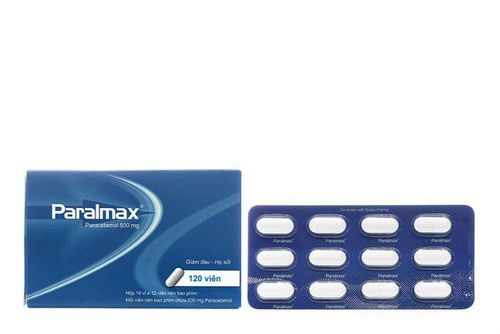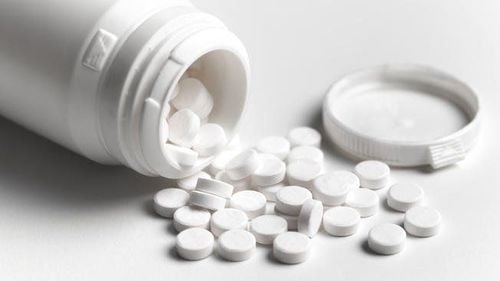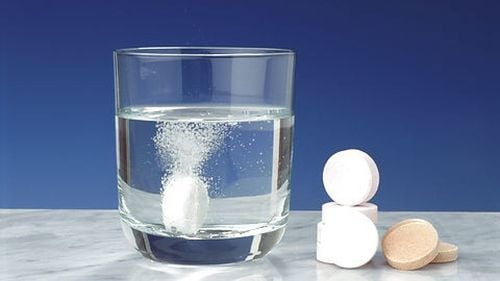This is an automatically translated article.
Paralmax medicine has ingredients including Paracetamol 500 mg and other excipients. This is a drug belonging to the group of non-steroid anti-inflammatory drugs with antipyretic, analgesic, anti-inflammatory effects, treating gout and other bone and joint diseases.
1. What are the effects of Paralmax?
Paralmax or Paracetamol is an effective pain reliever, antipyretic, anti-inflammatory drug. Drugs acting on the thermoregulatory centers in the hypothalamus cause hypothermia, increase thermogenesis due to vasodilation, and increase peripheral blood flow. is in the normal range. At therapeutic doses, Paracetamol has an analgesic and antipyretic effect equivalent to Aspirin, but Paracetamol has little impact on the cardiovascular and respiratory systems, does not change the acid-base balance, does not cause irritation and scratches or bleeding. stomach blood. Paracetamol is rapidly and almost completely absorbed from the gastrointestinal tract. The half-life is about 1.25 - 3 hours. The drug is metabolised in the liver and eliminated by the kidneys.
Paralmax is indicated in the treatment of:
Treatment of pain symptoms in the following cases: migraine, headache, toothache, pain due to flu, musculoskeletal pain, pain due to arthritis, back pain vaccination or tooth extraction. Reducing fever in people with colds or other fever-related illnesses, and does not affect the course of the underlying disease, and can destabilize the patient's condition.

Thuốc Paralmax có công dụng giảm đau hạ sốt
2. Dosage and how to use Paralmax
How to use: dissolve Paralmax tablets in the desired amount of water until the effervescence stops. The time between 2 doses must be more than 4 hours and not more than 8 tablets/day.
Adults and children > 12 years old: take 1 Paralmax tablet / time. Severe pain: adults can take 2 Paralmax pills / time. As directed by the treating physician. Notes on dosage:
Maximum therapeutic dose in 24 hours: for children, it is not more than 5 times a day. Do not prolong the self-administration of Paralmax without consulting a doctor when:
New signs appear. Fever above 39 degrees and persists for more than 3 days or recurs. Pain is severe and lasts for more than 5 days.
3. Paralmax drug overdose and how to handle it
Overdose of Paralmax drug due to a single toxic dose or repeated large doses of Paralmax (7.5 - 10g per day, for 1-2 days) or due to prolonged use of the drug. Dose-dependent hepatic necrosis is the most serious acute toxic effect of overdose and can be life-threatening.
Manifestations of Paracetamol overdose:
Nausea, vomiting; Stomachache; Cyanosis of the skin, mucous membranes and nails. Manifestations of severe poisoning with drugs Paralmax or Paracetamol such as:
Initially mild stimulation such as agitation and delirium; Central nervous system depression such as stupor, hypothermia, extreme fatigue, rapid and shallow breathing; Fast, weak, irregular pulse; Blood pressure drops and signs of circulatory failure. Treatment: Early detection and diagnosis are very important in the treatment of paracetamol overdose. When intoxication with Paracetamol is severe, it is necessary to receive active supportive treatment and perform gastric lavage in all cases, preferably within 4 hours after overdose. The main detoxification therapy is the use of Sulfhydryl compounds; N-acetylcysteine. These are compounds that are effective when taken orally or by injection/infusion. In addition, doctors may prescribe methionine, activated charcoal and/or salt bleach.

Người bệnh nên dùng thuốc Paralmax đúng liều lượng tránh quá liều
4. Undesirable effects of the drug Paralmax
Possible side effects when using Paralmax include:
Serious allergic skin reactions such as Stevens-Johnson syndrome (SJS), toxic skin necrosis syndrome (TEN) or syndrome Lyell's syndrome, acute generalized exanthematous pustulosis (AGEP). Liver failure (due to damage to liver cells) when taking high doses for a long time; Gastrointestinal signs such as digestive disorders, diarrhea; Signs of hemolysis in people with G6PD deficiency, uricuria or oxalate accumulation in the kidneys. This is not all of the possible side effects. You may experience other side effects with your body. If you have any questions about side effects, consult your treating doctor.
5. Interactions between Paralmax and other drugs and foods
Paralmax may change the way other medicines you are taking work or increase the effect of side effects. To prevent drug interactions, you should make a list of all medications you are taking (including prescription drugs, nonprescription drugs, herbs, supplements) with your treating doctor.
Before using medication. To ensure safety when using the drug, you must not arbitrarily use the drug and should not arbitrarily stop or change the dose of the drug without specific instructions from the treating doctor.
Paralmax may interact with anticoagulants (such as warfarin), phenothiazines, anticonvulsants (including phenytoin, barbiturates, carbamazepine), isoniazid. Vitamin C in the composition of the drug is a strong reducing agent, so in laboratory tests, vitamin C may cause deviations from biological tests (such as creatinine measurement, blood sugar test or blood sugar test). urine). Drinking too much and for a long time can increase the risk of paracetamol causing liver toxicity. In addition, certain foods and tobacco can also cause drug interactions. You should consult your doctor about taking the drug along with foods and cigarettes.
6. Notes before using Paralmax
Before taking medicine in the treatment of disease, you should tell your doctor or pharmacist if:
You are allergic to any of the ingredients in the medicine. You are taking other medicines (including prescription and over-the-counter medicines, herbal medicines and supplements). You have or have ever had a medical condition such as liver failure, kidney failure or other cardiovascular disease. Before surgery, tell your surgeon about all the products you use (including prescription drugs, over-the-counter medicines, and herbal products). During pregnancy, this medication should be used only when clearly needed and you need to discuss the risks and benefits with your doctor. For people who are suffering from phenylketonuria and who have to limit the amount of phenylalanine put into the body, they should avoid using Paracetamol or foods containing Aspartame. For some people with hypersensitivity (with asthma) it is advisable to avoid using Paracetamol with medicines or foods containing sulfites. Caution should be exercised in people with pre-existing anemia and impaired liver and kidney function because cyanosis may not be evident, even though they have high blood levels of methemoglobin. Ability to drive or use machines: Paralmax has no influence on the ability to drive and use machines. The drug Paralmax contains sodium, so you need to pay attention to your daily diet in case there is a salt diet indication.
7. How to store medicine
You should store Paralmax at room temperature, away from moisture and avoid direct exposure to light. Do not store medicine in the bathroom or in the freezer compartment of the refrigerator. You need to be aware that each medicine will have different storage methods. Therefore, you need to carefully read the storage instructions on the packaging or ask the pharmacist. At the same time, you need to keep the medicine out of the reach of children and pets.
You should not throw Paralmax tablets down the toilet or plumbing unless told to do so. Instead, you dispose of the medicine properly when it is past its expiration date or unusable. You can consult your local waste disposal company on how to safely dispose of Paralmax.
Please dial HOTLINE for more information or register for an appointment HERE. Download MyVinmec app to make appointments faster and to manage your bookings easily.













